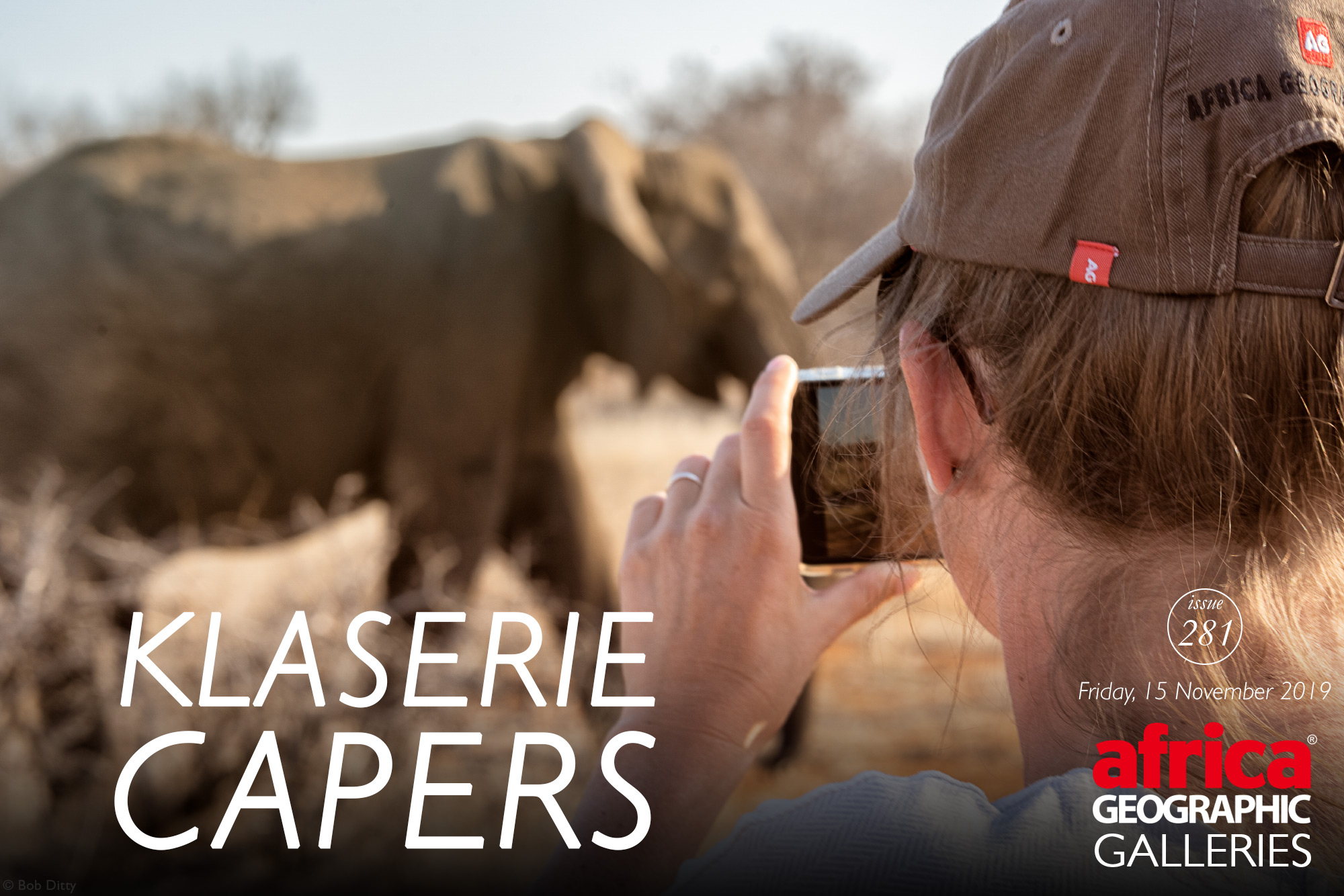
2019 Photographer of the Year winners on safari with our CEO

![]()
He emerged silently from the gloom and ambled towards us with that gentle rocking gait that big bull elephants use to cover vast distances with minimal effort. His white tusks glowed in the moonshine, but otherwise, he was just a huge dark grey smudge that loomed larger by the second. The eight of us sat motionless on the ground and in his path, wondering if he had seen us, and felt extremely insignificant.
At about fifteen metres, he noticed the eight seemingly legless humans and came to an abrupt halt, ears outspread, inquisitive and indecisive. Silence blanketed our group and the minutes ticked by as the elephant considered his options. Occasionally, he shuffled a little closer to get a better look at us, and as he raised his tusks in a bid to appear even larger and more intimidating, he was almost comical. Almost.
Next to me, Lizz was bravely staring wide-eyed at the gentle giant towering over us. I could hear her heart beating and sense her agitation, as fear and wonder battled for dominance. The instinct to stand up and run was almost overwhelming, but we obeyed Alan’s calm hand-signal instructions and wordlessly held our ground. At one stage, the huge grey ghost took a few steps towards one member of our team who was set apart from the rest by a few metres and Alan shifted his foot slightly as a distraction. The effect was dramatic as the elephant gave an exaggerated ear-clap, hit reverse gear and shuffled off. He met up with another bull about eighty metres away, and they had a brief discussion about us; often pointedly glancing in our direction. Discretion seemed to win the day, as they turned and melted away into the moon-shadows, like spirits of the African night.
We remained seated for a while, each lost in our thoughts, before picking our way back to the game drive vehicle about a hundred metres away. Not a word was spoken during the encounter, and no photos were taken, though I doubt that our gentleman elephant would have appreciated the flash. We all agreed that the overriding sense that we got from the giant creature was one of surprise and confusion, followed by curiosity. There was no anger, malevolence or belligerence. Alan drove the ten kilometres to our surprise bush dinner location on a hilltop with the vehicle lights off – the poacher’s moon provided ample light for navigation – which was a surreal and fitting end to a profoundly personal elephant encounter that will stay with each of us for the remainder of our days.
Naturally, this is an unusual way to encounter elephants and certainly should not be assumed to be the norm or attempted. I do provide context at the end of this story.
Our 2019 Photographer of the Year winner and two runners-up had joined Lizz and me on safari in Klaserie Private Nature Reserve, along with their companions. We enjoyed five days of fantastic wildlife sightings, culinary delights, wine and gin tastings and two fascinating and informative presentations from experts in their respective fields.
What follows is a selection of images from our group, with extended captions to provide the full story behind the photographs.
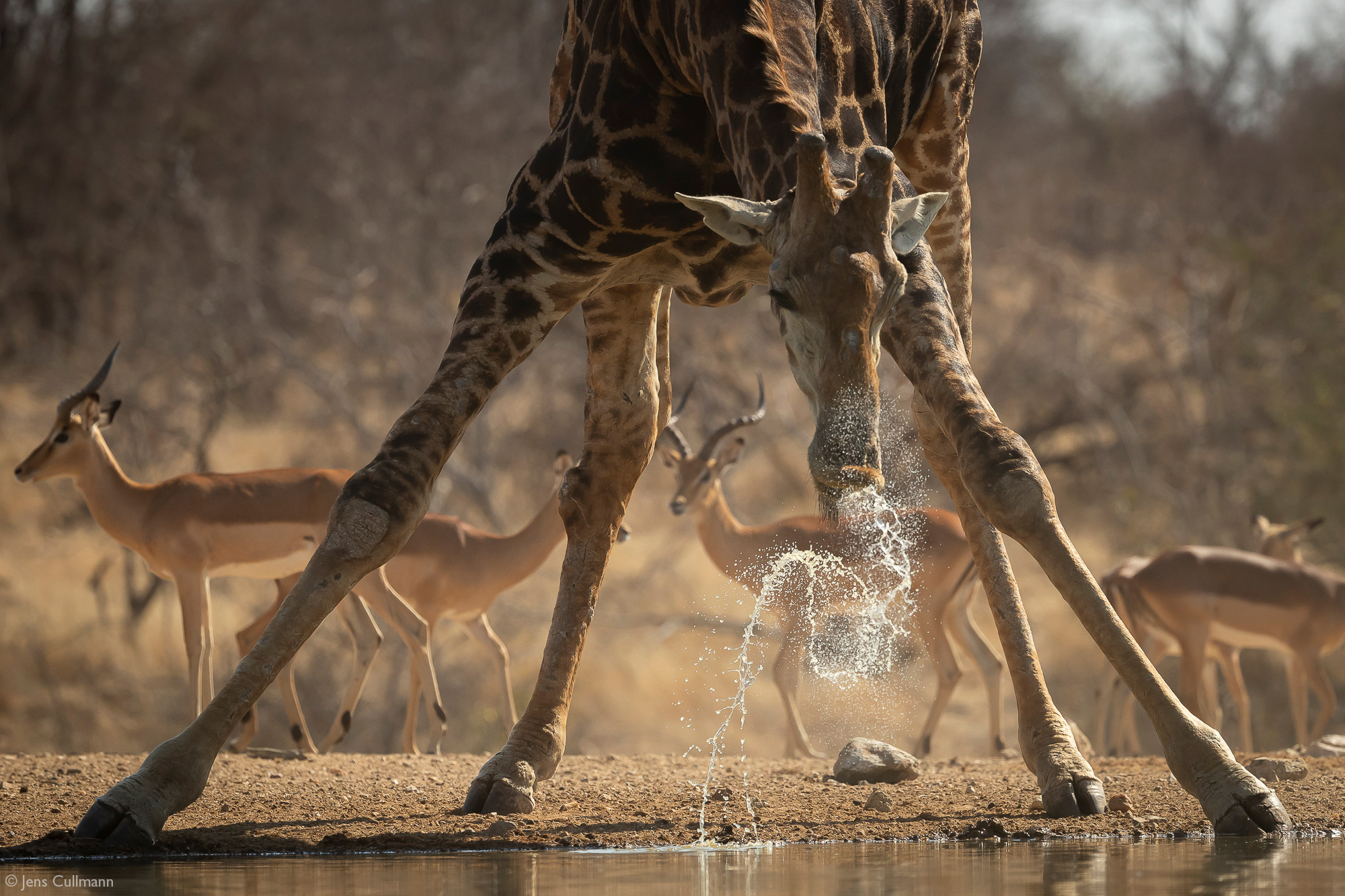
A giraffe bull interrupts his drink and jerks his head up in reaction to an impala alarm snort. The lips and epiglottis of a giraffe form two valves and the pumping action of the jaw creates the push effect for the water. This allows them to counteract gravity and pump water up the neck and into the oesophagus.
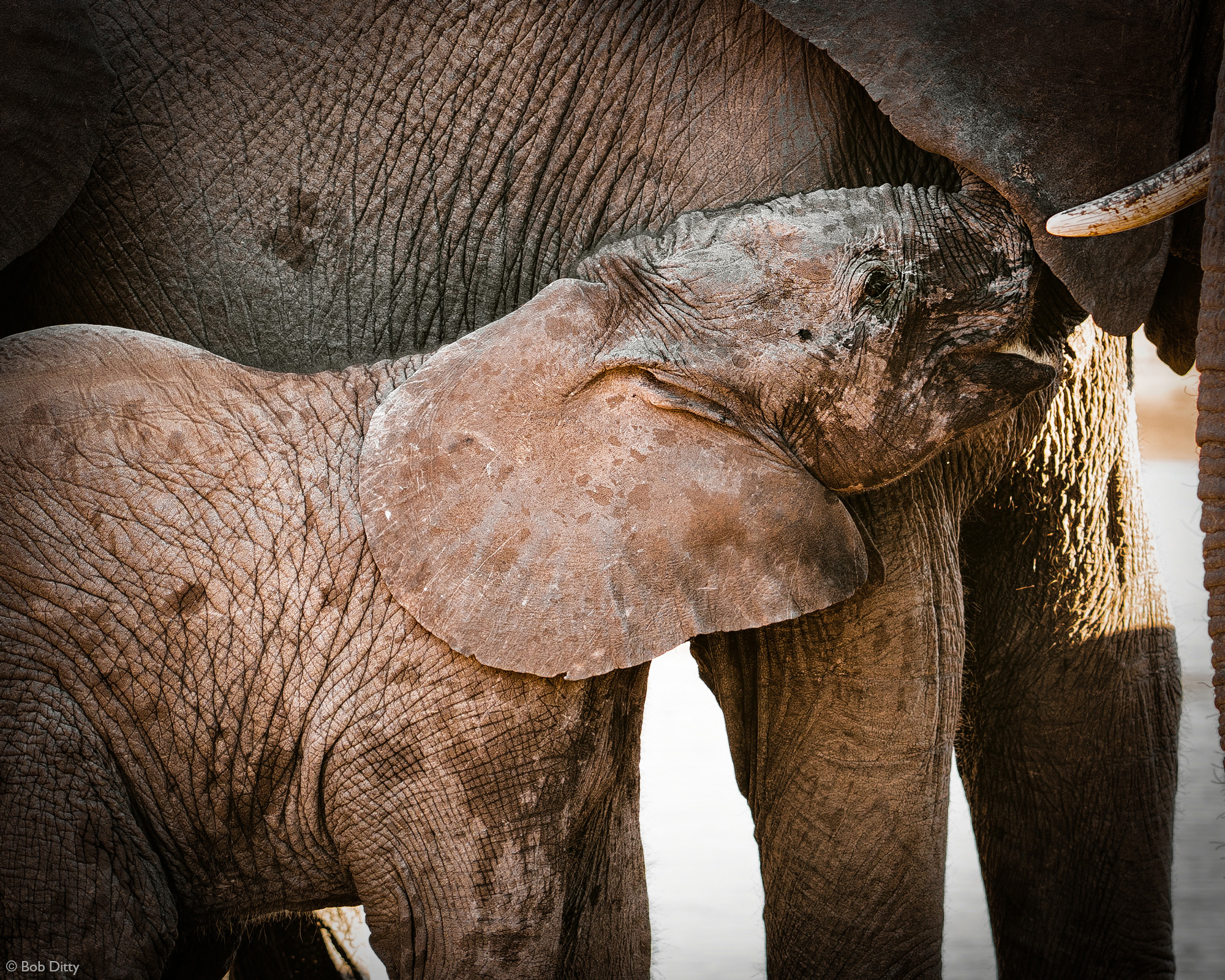
A baby elephant nurses from his mother. We were parked at a waterhole when a small family group arrived to drink water. They were unfazed by our presence a few metres from where they chose to drink, although a few tiny youngsters rolled their eyes at us and positioned themselves on the other side of larger herd members. The matriarch was always watching us and frequently rumbled to her herd as if to reassure them of our good intentions.

Jumping spider (subtribe Aelurillina). Our 2019 Photographer of the Year managed to find jumping spiders in the grounds of Amani Safari Camp and was lost in her own world for hours as she planned and took this image.

Yet another stunning sunset drinks stop, after a day of exploring Klaserie Private Nature Reserve.

Jens waited patiently for about 30 minutes for this stunning sequence. The immature gabar goshawk perched patiently and in full view on a dead tree overlooking a waterhole, as squadrons of golden-breasted buntings, lark-like buntings, red-billed queleas, blue waxbills, yellow-fronted canaries and Namaqua doves pulsed back and forth from the water’s edge. This golden-breasted bunting ventured too close to the raptor and paid for the mistake with his life. Jen’s reactions were lightning-fast, and burst mode settings ensured this marvellous sequence of images.

This young male leopard spent the better part of an hour lounging insouciantly around our game drive vehicle before deciding to relieve his boredom with several uncommitted hunting attempts. A scrub hare was the first to draw his attention, followed by a Natal francolin and finally, a party of blue waxbills drinking at a puddle of water!
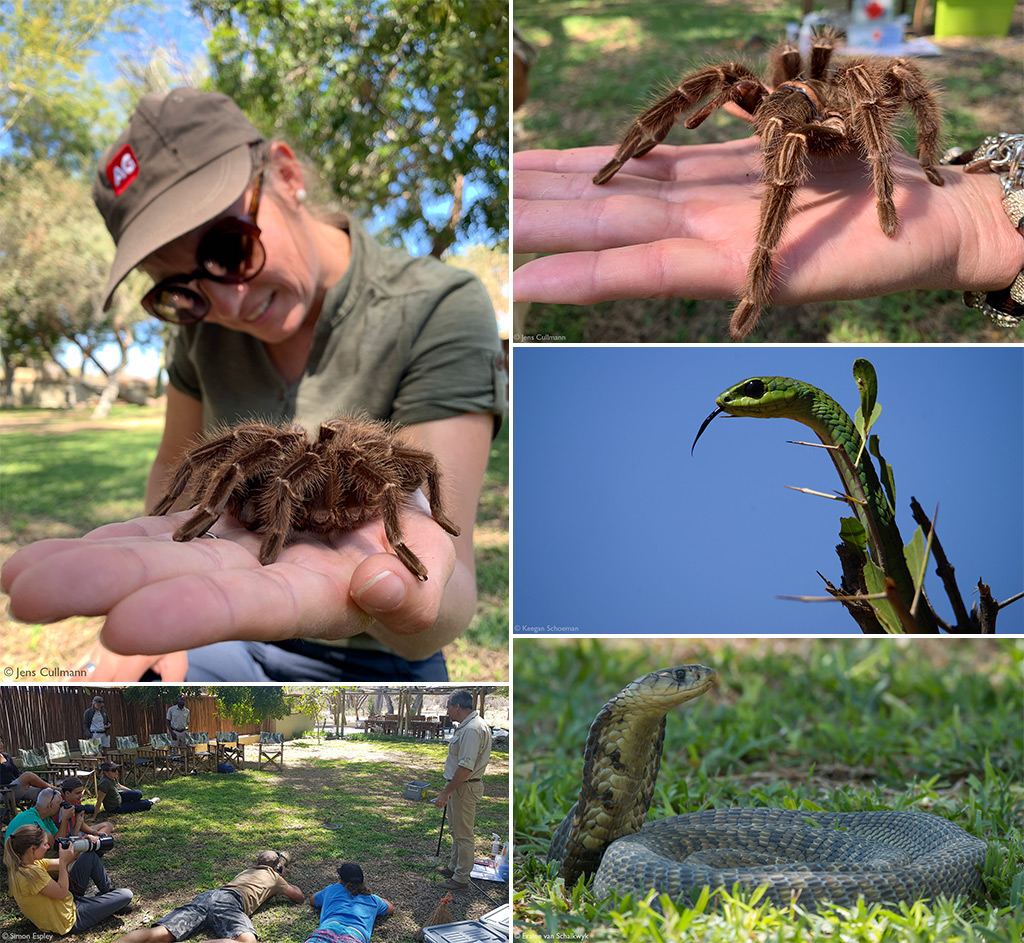
A highlight for many was a presentation by respected herpetologist Donald Strydom, whose passion for his topic had us enthralled and fascinated for over three hours. Donald debunked several myths about venomous snakes, including demonstrating just how reluctant puffadders and snouted cobras are to strike out at humans, even when provoked. He also gave a demonstration of how to handle a puffadder, for those of us likely to have to do so at some stage.
The underlying message was that wild animals belong in the wild and that every individual rescued or removed from homes was released as soon as possible into a safe area. The animals used in his demonstration were either due for release or were confiscated pets, such as the enormous birdeater spiders from South America. Donald is the curator of the Kinyonga Reptile Centre in Hoedspruit, a popular speaker at private functions and dangerous snake consultant for wildlife documentaries. We also enjoyed a thoroughly interesting presentation by Kyle Middleton of the APNR Ground Hornbill Project, and learned about this rather special and threatened bird whose haunting early morning call is such a fantastic soundtrack to wake up to. Our group was lucky enough to encounter two family parties of ground hornbills.
Clockwise from top left: 1) & 2) Goliath birdeater from South America © Jens Cullmann; 3) Boomslang (tree snake) © Keegan Schoeman; 4) Snouted cobra © Eraine van Schalkwyk; 5) Donald demonstrating how to move away from danger when in the presence of a large venomous snake such as this snouted cobra © Simon Espley.
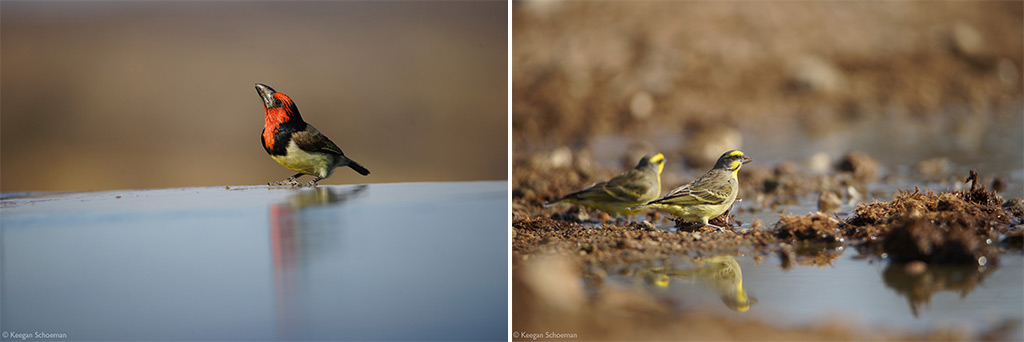
Left: This black-collared barbet visited the swimming pool during one hot afternoon, while we lounged around drinking copious amounts of iced beverages; Right: Yellow-fronted canaries slake their thirst at a waterhole. Both photos © Keegan Schoeman

Surprise, surprise! During an afternoon game drive, this is what awaited us in the shade of ancient trees along a sandy riverbed. To add to the alcoholic and culinary delights, on another evening, we were treated to a delightful wine and food pairing presented by Safari Wines of Hoedspruit – which lasted well into the night!

Elephants everywhere! There is no shortage of elephants in Klaserie, and we were treated to some exceptional encounters and learning experiences. Clockwise from top left: 1) An elephant family herd takes a drink at a waterhole © Jens Cullmann; 2) The elephants provided some great photographic opportunities © Bob Ditty; 3) A great capture of elephants heading off into the bush © Bob Ditty; 4) Jens looks on as an elephant passes by © Simon Espley; 5) A family herd with a young calf © Bob Ditty
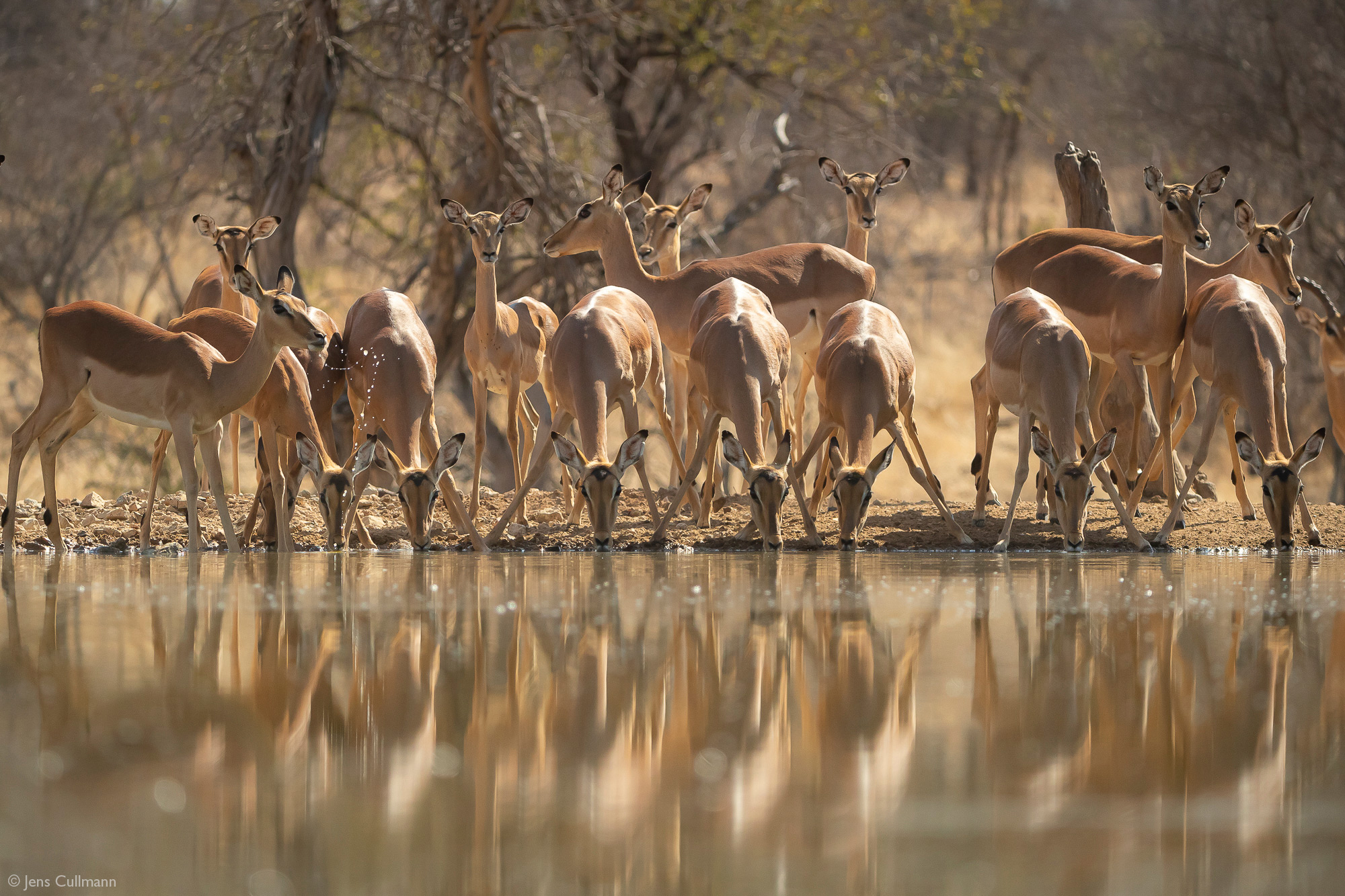
September signals the peak of the dry season in the Kruger area and herbivores are hard-pressed to meet their nutritional needs. The versatility of the impala feeding strategy confers an enormous advantage and allows them to switch to browsing leaves when the nutritious grass is no longer available. Many of the ewes are pregnant at this time of year and early to mid-November will bring lambing season – hopefully, the first rains of the season will arrive in time!

We spent one day walking between our two lodges, which was no mean feat considering that it was September and high summer temperatures had settled in. The pace was slow, and we took every opportunity to study spoor and other signs left by denizens of this neighbourhood. The route followed various dry riverbeds and kloofs, and we often stopped in the welcome shade of huge trees, sometimes settling down for lengthy periods to listen to life going on around us. Lunchtime was a welcome interruption, with a mouth-watering spread in the shade of riverine trees.
Clockwise from top left: 1) Private guide Alan McSmith illustrates his explanations in the sand during the walk © Bob Ditty; 2) The group walks through a dry riverbed © Simon Espley; 3) Alan chats to the group while taking a brief break © Bob Ditty; 4) An incredible lunch was a welcome interruption © Simon Espley
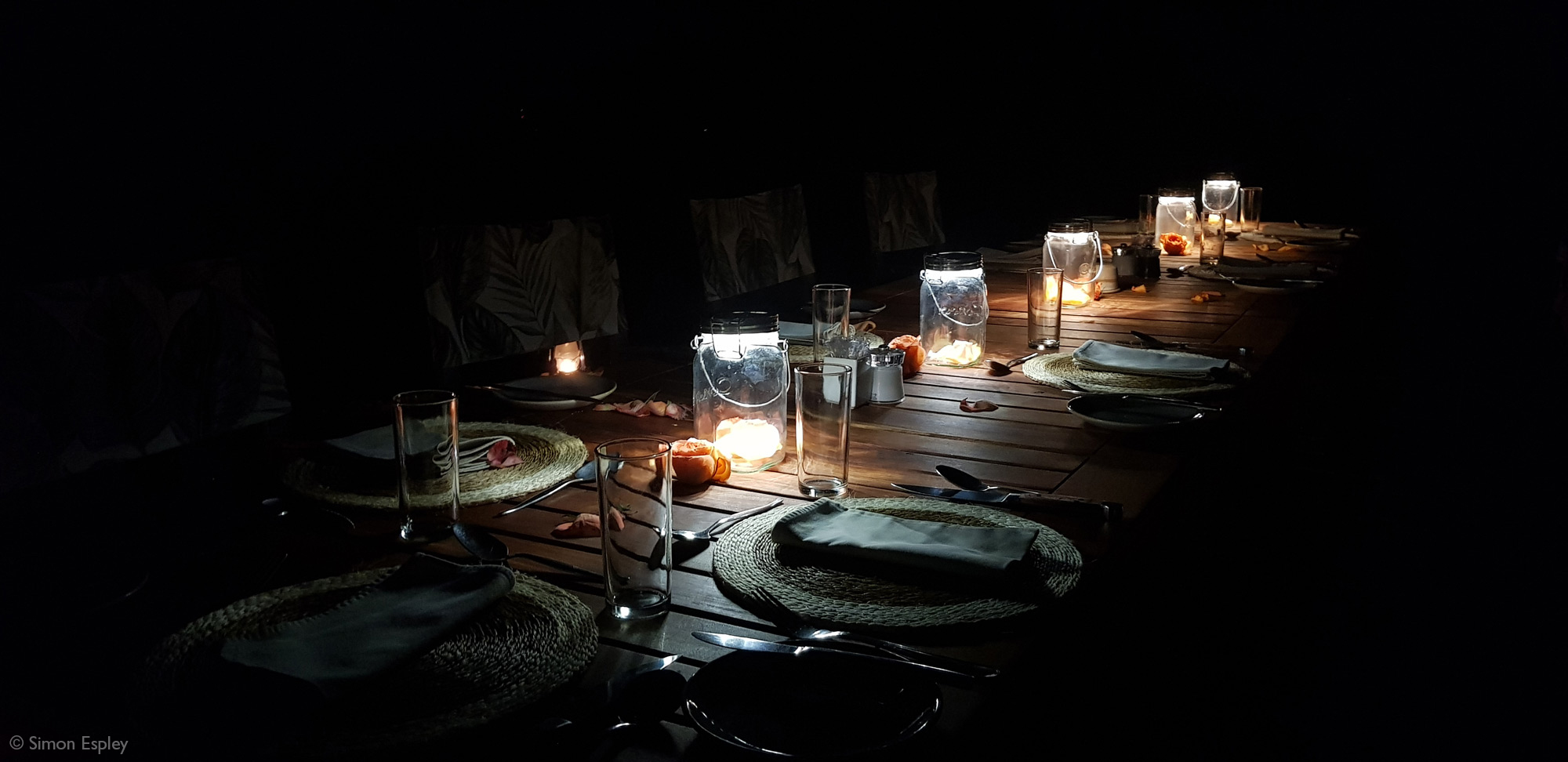
Surprise bush dinner on a hilltop.![]()

Klaserie’s final gift. The last game drive on the morning of our departure netted this exciting encounter. This small group of painted wolves (African wild dogs) loped over the coming rise and dashed past, all business and focus. We were simply part of the scenery to them.
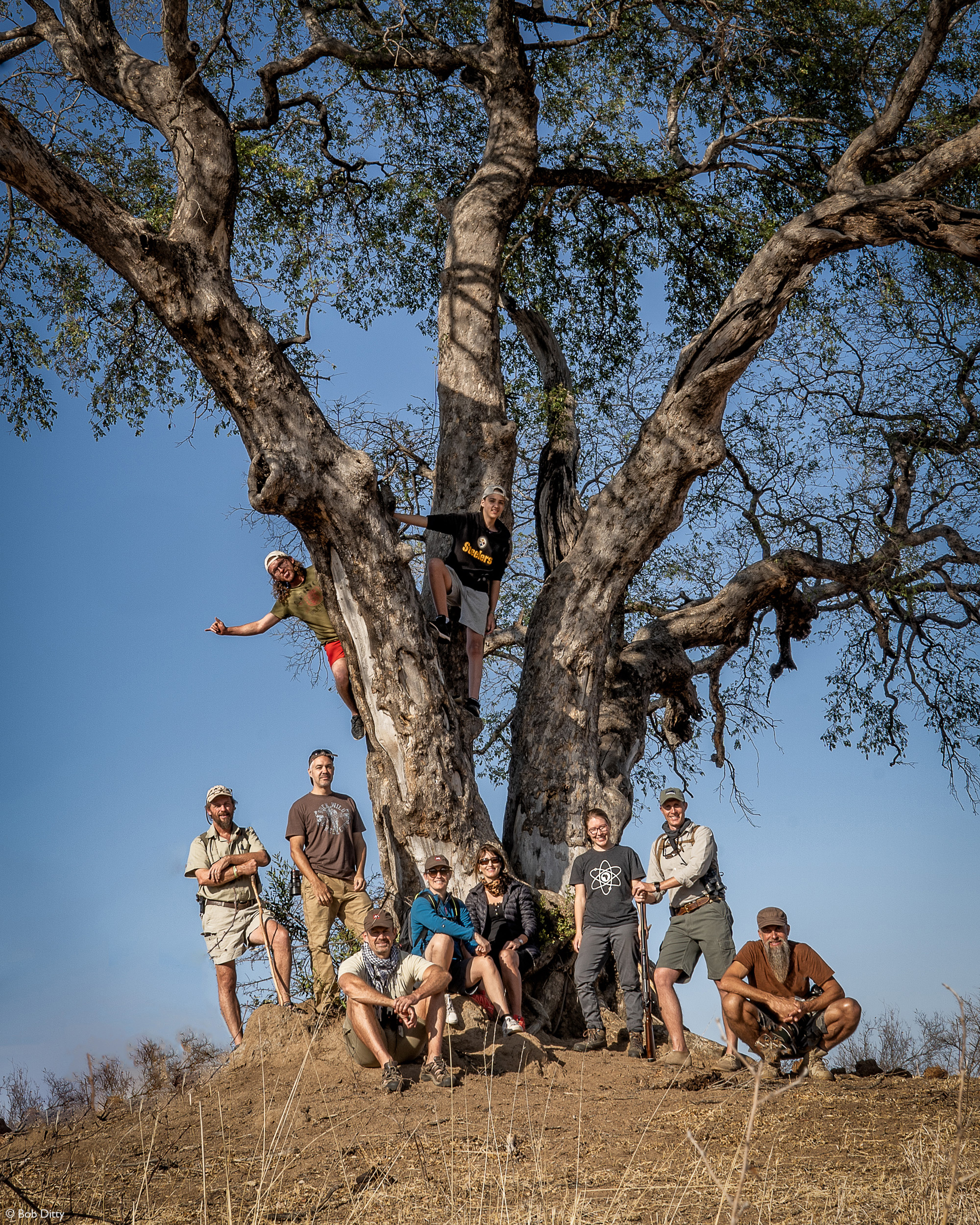
Our safari group, somewhere in Klaserie Private Game Reserve, under an ancient weeping boerbean tree: 2019 Photographer of the Year Eraine van Schalkwyk and her friend Keegan Schoeman; runner-up Jens Cullmann and partner Sophie Leemans; runner-up Bob Ditty and his son Luke; Africa Geographic CEO Simon Espley and his wife Lizz; private guide Alan McSmith and Klaserie Drift Safari Camps manager Dawie Jansen.
ABOUT THAT ELEPHANT ENCOUNTER, and our guide

Alan McSmith identifying spoor in the sand.
Earlier that evening, we had spent about an hour with the same two bull elephants who were feeding peacefully next to our vehicle. We left them to enjoy sundowner drinks a few kilometres down the track. Alan McSmith is a highly regarded and experienced private guide, who regularly hosts guests all over Africa. He was chosen to guide this special safari precisely due to his understanding of elephants. During the sundowner stop, Alan invited us to join him about a hundred metres from the vehicle, where we sat down, closed our eyes and zoned into our surroundings. Amidst the usual insect and bird calls as the darkness set in, the crack of a nearby breaking branch had us all glancing at Alan.
“OK,” he whispered, “the big guys have decided to join us for sundowners. We have two choices – we can either all go back to the vehicle, or we stay. If we stay, you obey my instructions. These bulls are relaxed, they are inquisitive, and they are walking into our space – all of which means that we are quite safe – so long as we all relax and let them find us and choose their way out of here.”
By deciding to stay put, we were treated to one of the most extraordinary elephant experiences imaginable.
ABOUT KLASERIE DRIFT SAFARI CAMPS
The Klaserie Drift Safari Camps are set on 3,000 hectares of prime land in the heart of the Klaserie Private Nature Reserve, offering a genuine, exclusive retreat into nature. The camps are ideally located for guests to enjoy all the wildlife Africa has to offer, in a private and secluded setting, featuring the Big 5, incredibly diverse landscapes and comfortable accommodation with all modern amenities.
Amani Safari Camp
Amani Safari Camp provides private, tranquil accommodation for eight guests in a large thatched villa. The layout of this camp is unique, comprising a central living area and four en-suite bedrooms. Each bedroom has its private garden entrance and large windows providing access to remarkable views of the bushveld. The central living area features two open plan lounges on the ground floor, as well as a library and a TV room on the open-air second level. The lounges open onto a large wooden deck which provides the perfect setting for the ultimate dining experience. A pathway leads to another outdoor lounge area with a swimming pool to allow you a moment to relax in the sunshine.
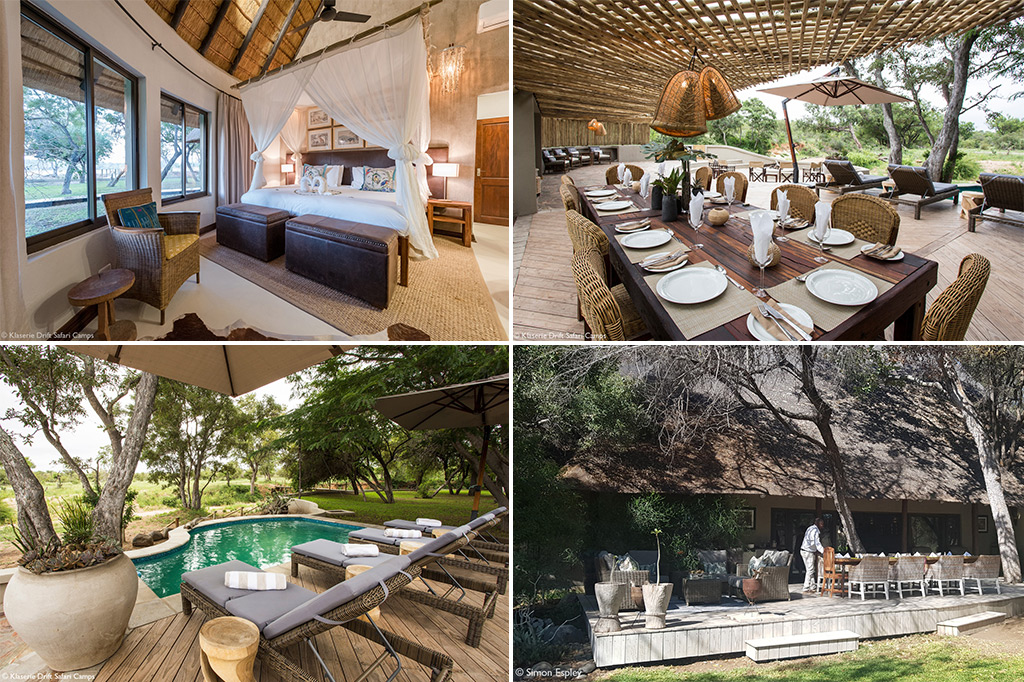
Misava Safari Camp
Misava Safari Camp is the perfect place to unwind, relax and enjoy what the Kruger bushveld has to offer. The new camp has been designed in line with nature – the name Misava is the Shangaan word meaning Earth. The camp overlooks the Klaserie River from the vantage point of a cliff. Misava has three elegant garden-view rooms and two opulent villas overlooking the river, each with its private deck area. The main building is adjacent to the dining area with casual seating and a fully stocked bar which then leads to the open-air boma/fire pit and a wooden deck overlooking a watering hole.
Check out our preferred camps & lodges for the best prices, browse our famous packages for experience-based safaris and search for our current special offers.
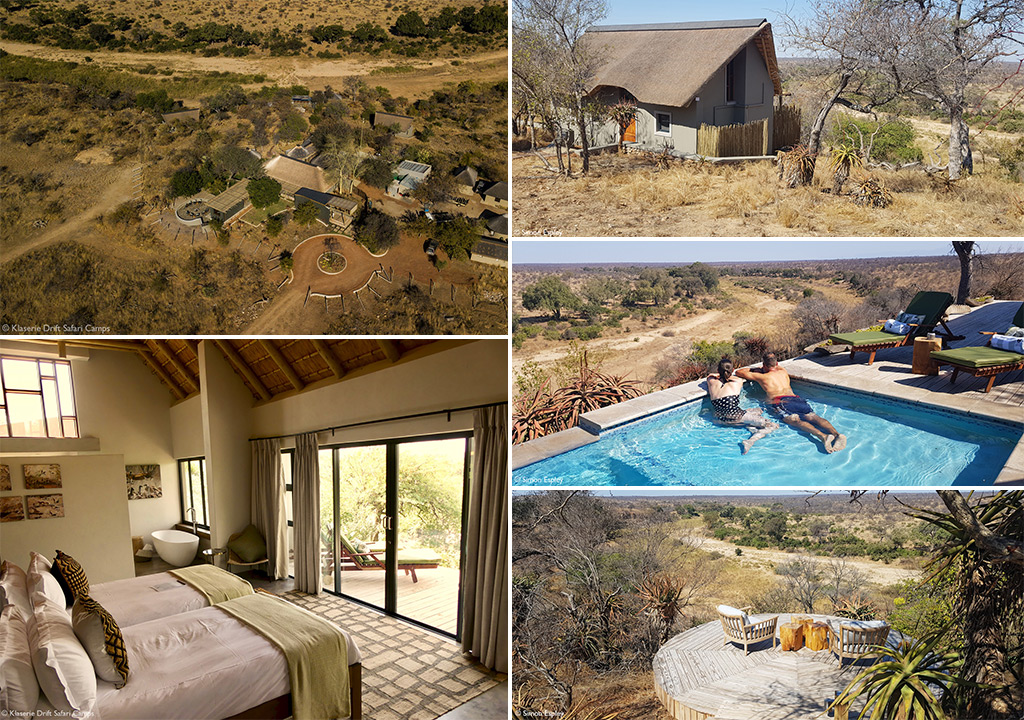
ABOUT THE AUTHOR, SIMON ESPLEY
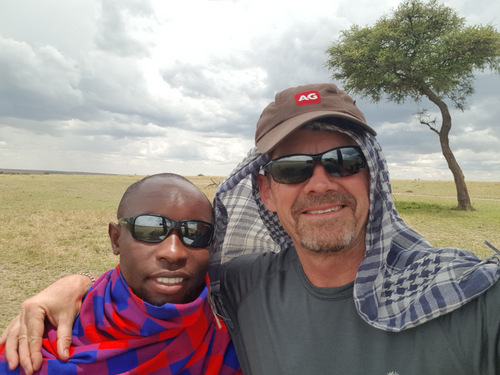
Simon Espley is an African of the digital tribe, a chartered accountant and CEO of Africa Geographic. His travels in Africa are in search of wilderness, real people with interesting stories and elusive birds. He lives in South Africa with his wife Lizz and two Jack Russells, and when not travelling or working, he will be on his mountain bike somewhere out there. His motto is ‘Live for now, have fun, be good, tread lightly and respect others. And embrace change.’
To comment on this story: Login (or sign up) to our app here - it's a troll-free safe place 🙂.![]()




